|
TennisOne Lessons The Dementieva Serve or Arm Action Breakdown Doug King This month we have featured Elena Dementieva in our ProStrokes Gallery. Dementieva is one of the finest ball strikers on the women’s pro tour. She has classic technique on her groundstrokes and has been one of the more consistent performers, finishing in the Top 10 the last four years. She hits a clean, fairly flat ball off both sides, takes the ball early, moves very well, and has a strong competitive spirit. But perhaps she is best known not for one of her assets but for her liability - and that is her serve. Truly, she has achieved not because of her serve but in spite of it. Few who watched can forget her service breakdown at the 2004 French Open final when she lost to countrywoman Anastasia Myskina.
In this article we will take a close look at the Dementieva serve and determine what some of her serving issues are. By identifying where breakdowns occur in a player of Dementieva’s caliber we can get a good idea of the common breakdowns that plague most players. We will start by identifying the key components of a good arm action (what we often call “snap”) and see how Dementieva integrates these components into her serve. In doing so we will compare Elena’s serve to other pro serves. Further on we will look at what steps Elena has taken to correct her technique. Finally we will suggest ways to overcome some of these common serving issues. The First Look On the first look at Dementieva’s serve we will see that she tends to throw the ball too far to the right and forward. This causes her arm to swing away from the body and approach the ball in a somewhat sidearm action so that she hits across the ball producing a sidespin delivery. Her arm sweeps down and across her body very quickly after contact indicating that she is not driving up and over the ball which is essential for overspin. Without some degree of topspin she has little margin of safety on her serve. Also, because her arm gets so far separated from the body we would say that she just “arms” her serve, robbing her serve of potential power, disguise, and versatility. The Deeper Look The obvious answer to correcting Dementieva’s serve is to change the toss location. This will allow her to achieve proper alignment on her serve. This is fairly obvious, so why has she not corrected this some time ago? As with most things it’s just not that easy. The problem is most likely that because of how she has served for so long she has gotten into a pattern of generating power through a specific biomechanical action. She has developed a bad habit. In her case it is whipping her arm at the ball. Her arm whips around her shoulder like a clock arm swings around the center of a clock face. She tends to use her body to add more power to this whipping action. This action is common on all swings but especially on the serve. Once she has ingrained this “feel” for power, it becomes extremely difficult for her to generate power using a different technique. So even if she gets the ball toss in the correct spot she may not produce much of a “hit” because she cannot feel how to properly execute a different power generation technique. In her case she must learn a new rhythm, a new feel for using the racquet, and a totally new series of movements involving the body and arm. So what is this arm and body motion that seems to allude her? Let’s take a look. Arm Action on the Serve: Rotation, Extension, and Rhythm
The correct arm and body movement on the serve is generally referred to as “snap” which is to be differentiated from the more problematic “swing” action. Although there is some debate over whether to call it a “wrist snap,” I certainly endorse the concept of a snap and would go so far as to call it a “rhythmic full body snap.” There are three key components in the service action that play a major role in the snap. One is rotation, two is extension, and three is rhythm. In truth all strokes are built upon the same principles and the serve is very similar to a forehand where considerable power is desired. Rotation and Grip We can start our discussion of the arm action by looking at the critical moments of contact and then working backwards from there. The wrist is the smallest, quickest, and in the service action, the final contributing body component in the stroke. If we grab a racquet and hold our arm up in a contact position for the serve and try to “snap” our wrist in the usual way (like dribbling a basketball), we will see that the action is both quite limited and uncomfortable. The typical way to grab the racquet to produce a conventional wrist snap is with the Eastern forehand grip. This is a strong grip that allows plenty of wrist flexion behind contact and has easy palm to racquet face orientation. However, the wrist snap using this grip eliminates any significant follow through and the follow through it forces is actually a pulling down action of the arm, or contraction. We call this the frying pan grip and the pancake serve. This pulling down action is the real problem in this conventional wrist snap and swing, as it produces backspin. Backspin is the least desirable spin on the serve since it will cause the ball to sail long.
The correct wrist action is produced by rotation. By taking the racquet in a Continental grip everything is changed. The wrist motion is now changed from flexion to rotation. A good way to feel this is to remove your racquet from your hand and while standing on the court with your arm raised near service contact position, extend your thumb as though hitchhiking and rotate it from the back fence to the front fence. Now pretend that you are trying to snap a piece of gum off of your thumbnail and up over the net. That is the correct wrist action on the serve as the racquet will act in the same way as the thumb. This action is based upon rotation which we call supination (rotating the thumb down and behind you) and pronation (rotating the thumb up and in front). Supination is the loading phase of the motion and pronation is the release phase. By practicing this rotation of the thumb you will notice that a vigorous pronation involves much more than just the wrist. In fact, it involves more of a rotation of the forearm than the wrist action and as we add more force to the action we naturally feel the shoulder contributing greatly to this action. You can feel that if done properly the wrist is kept relatively passive (relaxed) while the elbow snaps up and the shoulder rolls inward, toward the ear, while the forearm and hand execute this same rotation as the shoulder. This is very different from the traditional wrist snap that causes the arm to pull down because it actually encourages the arm to push up - what we sometimes call “lock out.” This is similar to the shoulder rotation in a freestyle swim stroke which is designed to lift the arm out of the water using the shoulder and then arc the arm as it reenters the water, fingertips first. By comparison the pancake serve is like a doggie-paddle swim motion. But the real payoff is that this technique encourages exactly the opposite spin, namely topspin. In the same way that backspin is bad on the serve, topspin is good. So to recap, the Continental grip will force a wrist action based upon rotation (supination and pronation) which is based upon upward extension and locking out as opposed to down ward contraction and swing, producing the desired effect of topspin. Extension and the Up and Over A vigorous pronation involves every part of the body contributing to the extension and rotation. The whole body will make a choreographed buildup of these two forces. The torso will coil and the legs will bend to begin the entire motion and then these two actions will rhythmically buildup and course through the body, culminating in the final twist of the racquet through contact. All parts of the body are involved in the flex and extension as well as the supination and pronation. A very confusing point of the serve is the notion of extension or “reaching up.” We are usually told to reach up for the serve. I don’t like the idea of “reaching” for any shot, serve included, as it tends to get people extending away and often out of alignment to their bodies. On the serve I prefer to say either “stretch up” or “straighten up.” Even the idea of straightening up can be very misleading because this often puts people into an alignment that is too “square” to the court, that is with the shoulders too level. In reality what we want to achieve is a straightening up or stretching out of the right side (hitting side) of the body. To do this you would actually have to lean to the left. By leaning to the left you would raise up your right shoulder. This is actually a stronger position on the serve. A good way to feel this is to take a heavy dumbbell in your right hand and raise it as high over your head as you can. You will notice that be tilting slightly to the left you will raise the weight higher and achieve a more stable position. Think of it this way; if you are standing straight your head is above your shoulders, so to get the maximum reach out, either your right or left arm would tilt to the opposite side so that your shoulder is in the position that your head would normally be if you were standing straight. This is the proper alignment when we stretch out on the serve, again similar to a swim stroke. This can be especially confusing when we are told to keep our heads up because in reality our heads should be tilted off to the side while it is the eyes that should be looking up at contact. This upward thrust in our extension is a critical part of getting the proper release of the racquet at contact. Extension and rotation are intertwined as they mutually support and facilitate each other. This produces an “up and over” feeling through contact, as the upward thrust of the body and upper arm tend to create the downward spill of the racquet after contact. This is the arcing action of the arm that sends the tip of racquet down before the elbow, in the same way that the fingertips enter the water first in a swim stroke.
If we compare the above two clips of Dementieva and Sharapova, we can see two entirely different motions. Both players are slicing the ball down the center of the Ad Court. On contact, we can see that Sharapova’s ball placement is much more to the left than Dementieva's. She is also better positioned under the ball, although she is still leaning nicely into the court. Dementieva shoulders are much more level to the ground, preventing good extension of the right side of the body. Her body is neither tilted to achieve proper extension nor leaning into the court. Through the hit we see that Sharapova drives up much more than Dementieva. You can almost imagine a booster seat underneath Sharapova, pushing her lower body up even after contact (notice her high rear leg kick at the finish). Notice also how Maria’s a upper arm stays elevated more through the pronation phase while Elena’s upper arm (elbow) collapses. There is very little pronation from Elena’s forearm or rotation from her shoulder. This is an example of Dementieva at her worst, when the ball toss gets away from her and she is forced into a weak effort. I don’t think this is a deliberate action since it is what I also see when she double faults. Still she needs to be more disciplined and simply catch these errant tosses. Release and Rhythm - Saving “The Trigger” To put the entire service motion together we need rhythm. But before we talk of the specifics of rhythm on the serve it is important to realize that the object is to build smoothly up to a final crescendo or “moment” of release. This is not a continuous swing in the sense of continuously swinging a lasso around your head. There is a definite feeling of straightening out and a specific moment of maximum force and acceleration even though the motion stays fluid and never stops or loses continuity form start until finish. To do this properly requires knowing exactly when to apply force, that is timing and rhythm.
Dementieva shows a common error is rhythm. She drops the racquet down into the back-scratching position and then makes a forceful movement coming out of this position initiated by a rather forceful body shift. This is where she tends to speed up her stroke. This is her acceleration point or her “trigger.” However, the “back-scratching” position should not be the trigger on the serve. The trigger actually occurs much later in the serve - very close to contact.
Accelerating in or out of the back-scratch is exactly like accelerating from the top of the swing in golf. Both will result in a loss of precision and deceleration through the contact. This release and maximum speed is achieved by making the stroke more fluid and continuous in the back-scratch and then building both speed and tension in the arm by raising the shoulder and elbow up to the contact and at the same time holding them back, while dragging and lagging the racquet head. The stroke will naturally increase in speed as it tightens into position simply by making the coiling actions of the arm smaller as the arm lifts. When the stroke releases it creates a moment of acceleration and then deceleration. If you release or accelerate too soon in the stroke, it is nearly impossible to have a second acceleration available at contact. An easy way to identify the timing of the release is to listen to the audible exhalation in the stroke. If the grunt comes in prior to the hit it can be an indication that the trigger point is too early. This is exactly what you hear with Dementieva. Even the sound of her grunt indicates she is exerting force and then still holding considerable tension within her body afterwards. This indicates she is not getting a “full release.” The audible exhalation should occur on the contact or just after and should be a full release of tension. The Old the New, The Good and the Bad: A Work in Progress
In case you think that pros don’t work on their technique, think again. We have seen it recently with Nadal on his serve (trying new positions then reverting back to old, familiar patterns). At Indian Wells and Miami we saw Mark Woodforde in Djokovic’s camp, apparently helping with his net play. Pros are constantly tinkering with their techniques trying to gain an advantage and make every stroke in their repertoire feel as comfortable and complete as their favorite stroke. In the case of Dementieva we know that she has sought guidance on her serve from Richard Kraijeck and we can see evidence of improving technique. If we look at the pictures below, we can see she has altered her body position so that she remains more closed (sideways to the net) through contact. This in an effort to keep her body from opening up too quickly. In the first photo, taken at Indian Wells in ’04 we can see that Elena is completely facing the net at contact. Notice how both feet are pointed directly at the net, as are her hips and chest. Her upper body is angled down and to the left and is really pulling the arm down in this direction. This used to be her normal serve rather than the exceptional errant motion.
If you look at the second photo you can see how much more sideways she is, taken in July of '06 at the Accura Classic in California. Her feet are angled to the net and her torso is facing more up and to the right. Her ball toss is back and to the left which allows her to lock into a much better alignment with her arm and body as opposed to the reaching out in front of the body on the first photo. This is indicated by the much better head position on the second photo. Her head is more angled to the left in the freestyle swim position, looking up and to the right, rather than looking forward with a more upright head position as she shows in the first photo. In the third photo she has her body holding better alignment, more upright and angled to the right but her toss has gotten much too far right forcing her to adjust with a swiping arm action. In the fourth photo she seems to have reverted back to her old style where the ball toss is not so far right in this case but it is low and forward and her body has opened up and pulled to the left.
Even though it appears that she is working to adjust the toss and get her body better aligned, still the motion gets away from her. Even on her good serves she lacks upward drive, extending and rotating the arm on contact, and rhythm. But her problem now seems to be that she ends up with so many ball toss variances and body position variances at contact that it is no wonder that she has consistency problems. This leads me to believe that it is primarily a rhythm issue, such as swinging the racquet back too quickly during the toss (notice that she has her racquet relatively high at the release of her toss) which affects her toss placement, and also ends up causing a hitch in her motion and a subsequent improper opening up of her body to reinitiate momentum and premature acceleration in the back-scratch. It is a domino effect and what gets the chain started is not easy to identify. On the one hand you could say the fault lies in the bad tosses (I wouldn’t argue). On the other hand the bad tosses could be a way to accommodate an urge to let her arm swing out in her old familiar style. Once a habit sets in, it takes on a life of its own. That habit will fight for dominance and will undermine other corrective measures, at times necessitating a complete overhaul.
The Greatest With incredible flexibility and timing, Sampras shows the uncanny service form that was the foundation of his dominance. Tremendous extension and rotation characterized his motion, signified by his extreme pronation and locking of his upper arm at contact. One of the reasons his serves was so effective was disguise. On this serve down the T the ball toss does not give away location. Compare this to the clips of Dementieva above. I know it is difficult to make these kinds of comparisons as each player is different in so many ways. Still there is definite room for improvement with Dementieva and I hope that she continues on the right course. Techniques for Developing a Good Arm Action A great technique that will help you to develop a good arm action is to kneel on the court and serve off of one knee (put a towel under your knee for protection). This old standard is a great way to make sure that you use more extension and rotation in your action since if you use an improper grip or overswing, you will probably end up smashing your racquet into the court. Start slowly to avoid this costly mistake. Serving from this position will force you to keep the upper arm elevated while you rotate the shoulder and forearm for power.
Remember that you are not trying to feel “swing” in the arm or racquet as this will cause a breakdown in rhythm and alignment. Instead you should only feel the racquet lag and drag until the latest possible moment. Do not swing the racquet out of the back-scratch. Instead use the tilt of the hips and the raising of the shoulder to lift the racquet passively out of the back-scratch. In fact, the racquet should be rotating to the right of the ball as the arm is lifted out of the back-scratch to increase tension (supination) instead of making a swinging approach at the ball. My intent in this article is not to deride Dementieva’s serve. She possesses a good serve but unfortunately it is not as consistent as it needs to be. She is a fabulous player with incredible talent and opportunity and one of those opportunities is there in her serve. In the same way that we can learn from watching how the pros do things right we can also learn by understanding how they do things wrong. After all, it is always reassuring to recognize a little bit of ourselves in our heroes. Your comments are welcome. Let us know what you think about Doug King's article by emailing us here at TennisOne.
Doug is one of the country's foremost tennis teaching innovators. Founder of Acceleration Tennis, a revolutionary teaching system, King is leading the way in reinterpreting the traditional tennis model. Doug King is currently Director of Tennis at Meadowood Napa Valley ( www.meadowood.com ), a Relaix Chateau Resort in St. Helena , CA . For more information on Acceleration Tennis please email Doug King at dking@meadowood.com. |

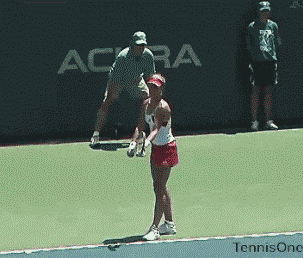
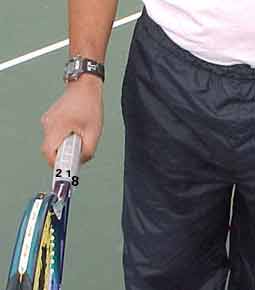
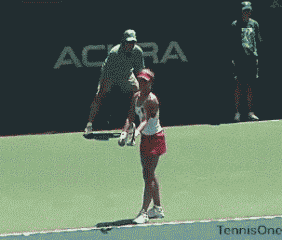
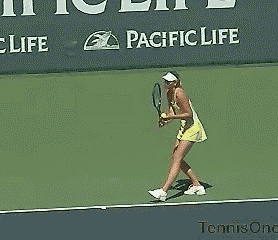
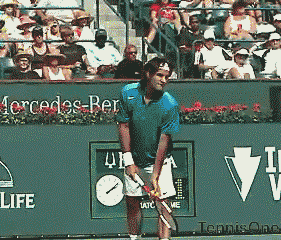
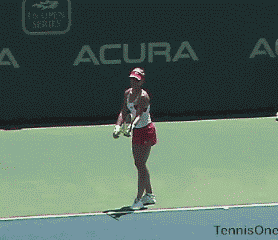
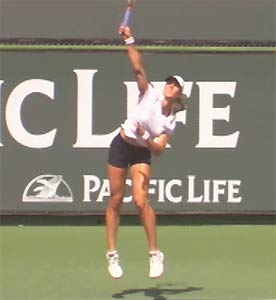
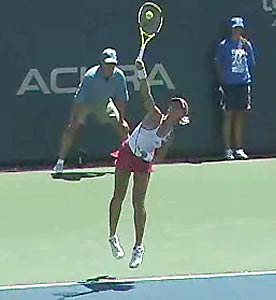
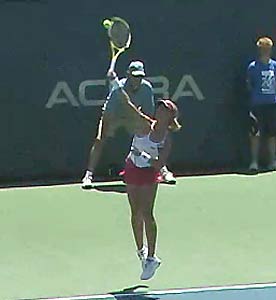
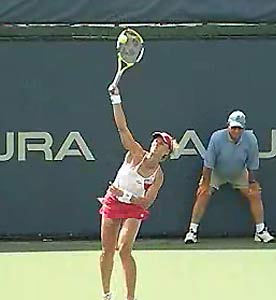
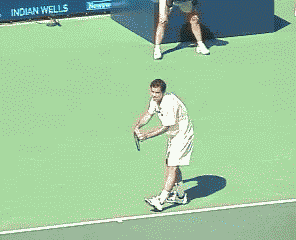
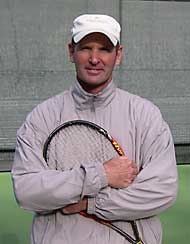
 Doug King studied with legendary tennis coach Tom Stow and was a
former California State Men's Singles Champion
and the former number one men's player of Northern California.
Doug King studied with legendary tennis coach Tom Stow and was a
former California State Men's Singles Champion
and the former number one men's player of Northern California.